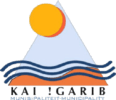Kai ǃGarib Local Municipality
| Kai ǃGarib | ||
|---|---|---|
| Local municipality | ||
| ||
.svg.png) Location in the Northern Cape | ||
| Coordinates: 29°0′S 20°30′E / 29.000°S 20.500°ECoordinates: 29°0′S 20°30′E / 29.000°S 20.500°E | ||
| Country | South Africa | |
| Province | Northern Cape | |
| District | ZF Mgcawu | |
| Seat | Kakamas | |
| Wards | 9 | |
| Government[1] | ||
| • Type | Municipal council | |
| • Mayor | Gina Cloete | |
| Area | ||
| • Total | 26,358 km2 (10,177 sq mi) | |
| Population (2011)[2] | ||
| • Total | 65,869 | |
| • Density | 2.5/km2 (6.5/sq mi) | |
| Racial makeup (2011)[2] | ||
| • Black African | 28.3% | |
| • Coloured | 62.2% | |
| • Indian/Asian | 0.8% | |
| • White | 6.3% | |
| First languages (2011)[3] | ||
| • Afrikaans | 71.9% | |
| • Tswana | 24.2% | |
| • English | 1.2% | |
| • Other | 2.7% | |
| Time zone | SAST (UTC+2) | |
| Municipal code | NC082 | |
Kai ǃGarib is an administrative area in the ZF Mgcawu District of Northern Cape in South Africa. The name Kai ǃGarib originates from the Khoi language and means "big great river", referring to the Orange River that flows through the area.[4]
Main places
The 2001 census divided the municipality into the following main places:[5]
| Place | Code | Area (km2) | Population |
|---|---|---|---|
| Alheit | 31601 | 7.88 | 683 |
| Augrabies Mission | 31603 | 0.32 | 287 |
| Augrabies | 31602 | 4.42 | 2,694 |
| Bloemsmond | 31604 | 1.02 | 315 |
| Cillie | 31605 | 6.57 | 2,454 |
| Kakamas | 31607 | 4.96 | 7,303 |
| Kanoneiland | 31608 | 0.26 | 247 |
| Keimoes | 31609 | 26.34 | 9,397 |
| Kenhardt | 31610 | 4.24 | 3,796 |
| Lennetsville | 31611 | 0.16 | 1,499 |
| Louisvale | 31612 | 8.61 | 1,088 |
| Loxtonberg | 31613 | 1.58 | 708 |
| Lutzburg | 31614 | 0.25 | 1,302 |
| Marchand | 31615 | 4.86 | 2,391 |
| Raaswater | 31616 | 0.32 | 1,980 |
| Riemvasmaak | 31617 | 1.60 | 696 |
| Remainder of the municipality | 31606 | 7,376.80 | 20,830 |
Politics
The municipal council consists of seventeen members elected by mixed-member proportional representation. Nine councillors are elected by first-past-the-post voting in nine wards, while the remaining eight are chosen from party lists so that the total number of party representatives is proportional to the number of votes received. In the election of 18 May 2011 the African National Congress (ANC) won a majority of ten seats on the council. The following table shows the results of the election.[6][7]
| Party | Votes | Seats | ||||||
|---|---|---|---|---|---|---|---|---|
| Ward | List | Total | % | Ward | List | Total | ||
| African National Congress | 9,949 | 10,023 | 19,972 | 58.1 | 8 | 2 | 10 | |
| Democratic Alliance | 4,380 | 4,472 | 8,852 | 25.8 | 0 | 4 | 4 | |
| Congress of the People | 2,783 | 2,718 | 5,501 | 16.0 | 1 | 2 | 3 | |
| Independent | 42 | – | 42 | 0.1 | 0 | – | 0 | |
| Total | 17,154 | 17,213 | 34,367 | 100.0 | 9 | 8 | 17 | |
| Spoilt votes | 272 | 235 | 507 | |||||
References
- ↑ "Contact list: Executive Mayors". Government Communication & Information System. Retrieved 22 February 2012.
- 1 2 "Statistics by place". Statistics South Africa. Retrieved 27 September 2015.
- ↑ "Statistics by place". Statistics South Africa. Retrieved 27 September 2015.
- ↑ South African Languages - Place names
- ↑ Lookup Tables - Statistics South Africa
- ↑ "Results Summary – All Ballots: Kai ǃGarib" (PDF). Independent Electoral Commission. Retrieved 24 November 2013.
- ↑ "Seat Calculation Detail: Kai ǃGarib" (PDF). Independent Electoral Commission. Retrieved 24 November 2013.

.svg.png)
.svg.png)